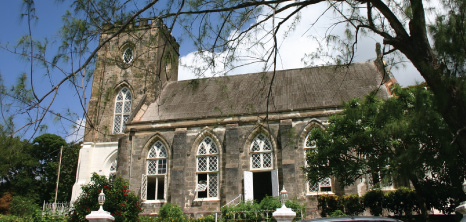|
History of the Anglican Church in BarbadosOriginally, the Anglican Church was referred to as the Church of England. It's existence here in Barbados spans more than three hundred (300) years and it should come as no surprise that this particular religion made its way to Barbados, as at the time of the island's settlement it was the state religion in England.
Barbados embraced the appointment of the first Bishop, Rev. Dr. William Hart Coleridge in 1824. Bishop Coleridge's arrival to Barbados on January 29, 1824 saw an increase in Anglican churches and clergymen.
The education system in Barbados benefited tremendously from the first Bishop, William Hart Coleridge. The vestries administered parish schools but the church didn't really play a major part in the execution of the education that was offered. A restricting education Education in these schools were restricted to the three R's (reading, 'riting and 'rithmetic). Writing was not extended to the slaves except those on the Codrington estates in St. John. Schools for slaves were few at first, though this improved during the early episcopate of Bishop Coleridge.
In 1842, Bishop Coleridge was succeeded by Bishop Thomas Parry, hence the entitlement of the Coleridge and Parry School in St. Peter.
In 1873, Barbados' third Bishop, John Mitchinson, was enthroned. His enthronement saw some relatively significant changes in Barbados' educational system such as the 1878 Education Act that brought about a more systematic approach to Barbados' educational structure, especially that of the secondary school level. In that same year, Bishop Mitchinson was appointed the first President of the Education Board. Through his efforts, he was able to successfully build and continue relations between Codrington College and Durham University which resulted in the advancement of higher education for the clergy and the community at large.
The church continued to play an integral part in Barbados' educational system as it introduced the first teacher education programme to the Caribbean. This introduction came about under the Principal at Codrington College, Richard Rawle, who in 1847 took personal responsibility for coordinating lectures during vacation time at the College for persons involved in teaching. These programmes ran until his resignation in 1864.
Such was the impact of former Codrington College Principal, Richard Rawle, that in 1912, the Rawle Institute was established by another Principal of the College, Rev, A. H. Antsey. The purpose of this institution was to train teachers in both Barbados and the Eastern Caribbean until it was replaced with Erdiston College which was opened in 1948.
Other areas of interest for the Anglican church in Barbados included the formation of the General Hospital which included board members such as the Bishop and the Archdeacon from time to time. Under the Bishop and the Archdeacon, birth was given to the Barbados Mutual Assurance Society.
The original Diocese of Barbados and the Leeward and Windward Islands established in 1824 was subsequently divided into five: Guyana (1842) and Antigua (1842), Trinidad (1872), Windward Islands (1879). Windward Islands continued to be administered by the Bishop of Barbados until 1930. These five together with the Dioceses of Jamaica (1824), Nassau and the Bahamas (1861) and Belize (formerly British Honduras) (1891) make up the Province of the West Indies. In 1951 the Diocese of Barbados elected its first native Bishop, Gay Lisle G. Mandeville.
The disestablishment and disendowment of the Anglican Church came about on April 1, 1969. The Anglican Church Act 1969 (Cap.375) is an Act of Parliament and it gave the Church the full responsibility of maintaining its own buildings, paying its clergy and managing its own affairs. As a result, the Anglican Church in Barbados has the necessary resources in place to function and survive without outside assistance.
00-2
|



